How to avoid getting scammed "Unusual Sign-in Activity" and similar email scams
Phishing/ScamAlso Known As: Unusual Sign-in Activity phishing email
Get free scan and check if your device is infected.
Remove it nowTo use full-featured product, you have to purchase a license for Combo Cleaner. Seven days free trial available. Combo Cleaner is owned and operated by RCS LT, the parent company of PCRisk.com.
What is "Unusual Sign-in Activity" email scam?
After examining this email, we learned that the scammers behind it attempt to trick recipients into providing their login credentials. They claim that the email account has been suspended due to unusual sign-in activity. They aim to trick recipients into opening the provided page and entering their passwords.
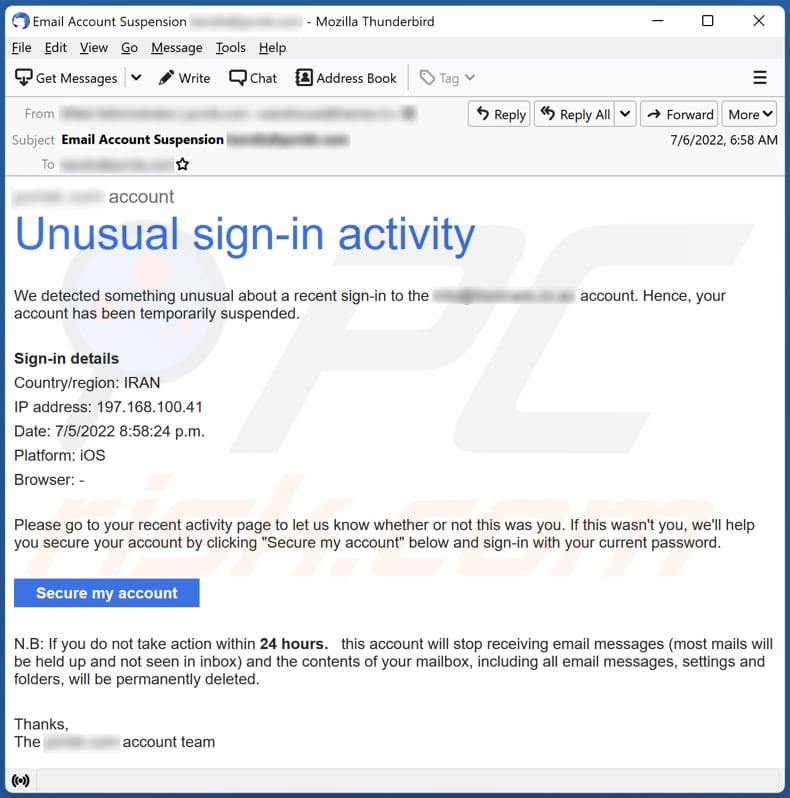
More about the "Unusual Sign-in Activity" email scam
Scammers behind this email claim that they have detected something unusual about a recent sign-in to the email account. They provide fake sign-in details such as IP address, country/region, date, operating system, and a web browser.
They state that the email account will stop receiving messages, and messages, settings, and folders will be deleted if recipients do not act within 24 hours. The email has the "Secure my account" hyperlink designed to open a fake Webmail page. Scammers use it to obtain email addresses and passwords.
Typically, scammers sell extracted information to third parties or misuse it by themselves. They also try to access other accounts (e.g., social media, banking, gaming, and other accounts). Emails of this kind and websites must be ignored. Providing information on such pages can lead to monetary loss, identity theft, loss of personal accounts, and other issues.
| Name | Unusual Sign-in Activity Email Scam |
| Threat Type | Phishing, Scam, Social Engineering, Fraud |
| Fake Claim | Incoming messages are suspended due to an unusual sign-in activity |
| Disguise | Letter from the email service provider |
| Symptoms | Unauthorized online purchases, changed online account passwords, identity theft, illegal access of the computer. |
| Distribution methods | Deceptive emails, rogue online pop-up ads, search engine poisoning techniques, misspelled domains. |
| Damage | Loss of sensitive private information, monetary loss, identity theft. |
| Malware Removal (Windows) |
To eliminate possible malware infections, scan your computer with legitimate antivirus software. Our security researchers recommend using Combo Cleaner. Download Combo CleanerTo use full-featured product, you have to purchase a license for Combo Cleaner. 7 days free trial available. Combo Cleaner is owned and operated by RCS LT, the parent company of PCRisk.com. |
Similar scams in general
In most cases, emails of this type are disguised as letters from legitimate entities (e.g., email service providers, banks, couriers). They are used to trick recipients into providing login credentials, credit card details, and other sensitive information.
A couple of examples of email scams are "Whats App - Missed Voice Message Email Scam", "Your Group Sent You A Message Email Scam", and "Message Failure Receiving Notice Email Scam". Emails can be used not only to extract information but also to deliver malware.
How do spam campaigns infect computers?
When cybercriminals use emails to deliver malware, their goal is to trick recipients into executing a malicious attachment or a file downloaded via a website link. In most cases, they use malicious MS Office, PDF documents, JavaScript files, archives (e.g., ZIP, RAR), executables, and other files to distribute malware.
Certain files do not infect computers unless users perform more than one step. For example, malicious MS Office documents cannot inject malware without enabling macros commands (editing/content). However, executable files start the infection chain right after they are opened/executed.
How to avoid installation of malware?
Do not open attachments and links in irrelevant emails sent from unknown addresses. Opening files downloaded from or through such emails can lead to computer infections. Also, download software (and files) from official websites. Do not use P2P networks, unofficial pages, third-party downloaders, and similar sources.
Keep the operating system and installed programs up to date. Activate and update them with tools/functions provided by their official developers. Use reputable antivirus software for computer protection. Run system scans regularly.
If you've already opened malicious attachments, we recommend running a scan with Combo Cleaner Antivirus for Windows to automatically eliminate infiltrated malware.
Text presented in the "Unusual Sign-in Activity" email letter:
Subject: Email Account Suspension ********
******** account
Unusual sign-in activity
We detected something unusual about a recent sign-in to the info@foodcare.co.ao account. Hence, your account has been temporarily suspended.
Sign-in details
Country/region: IRAN
IP address: 197.168.100.41
Date: 7/5/2022 8:58:24 p.m.
Platform: iOS
Browser: -
Please go to your recent activity page to let us know whether or not this was you. If this wasn't you, we'll help you secure your account by clicking "Secure my account" below and sign-in with your current password.
Secure my account
N.B: If you do not take action within 24 hours. this account will stop receiving email messages (most mails will be held up and not seen in inbox) and the contents of your mailbox, including all email messages, settings and folders, will be permanently deleted.
Thanks,
The ******** account team
Screenshot of the fake Webmail page:
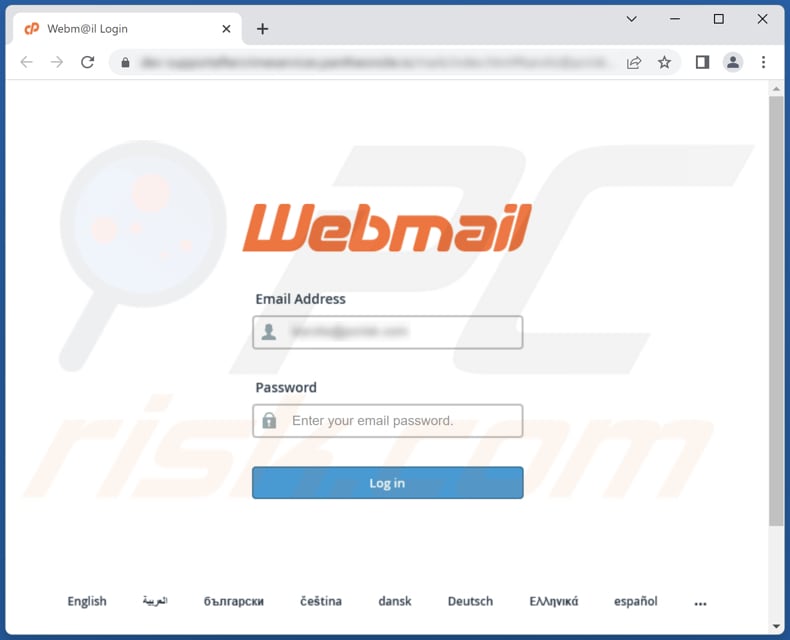
Another example of an email from "Unusual Sign-in Activity" spam campaign:
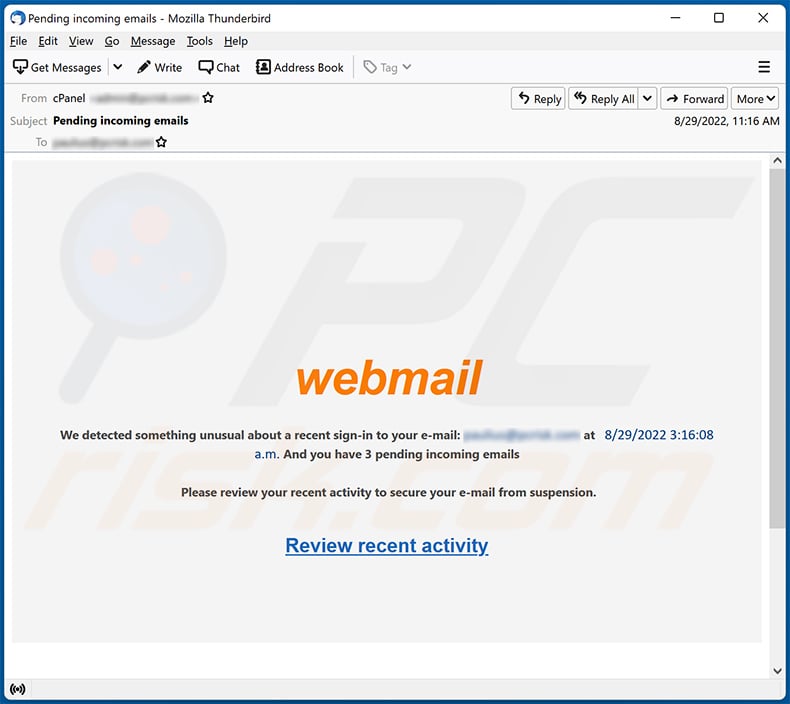
Text presented within:
Subject: Pending incoming emails
webmailWe detected something unusual about a recent sign-in to your e-mail: - at 8/29/2022 3:16:08 a.m. And you have 3 pending incoming emails
Please review your recent activity to secure your e-mail from suspension.
Review recent activity
CpCopyright© 2021 cPanel, Inc.
Screenshot of the promoted phishing site:
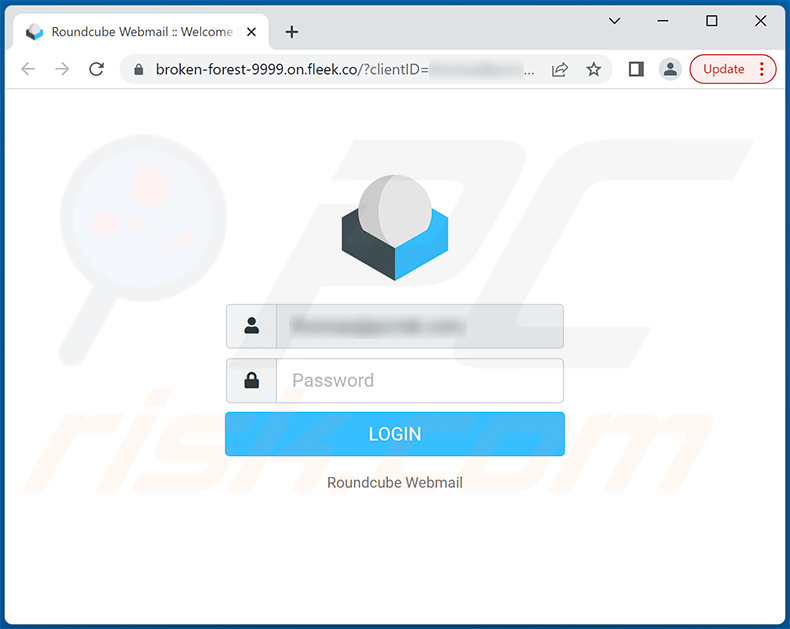
Another example of unusual sign-in activity-themed spam email promoting a phishing site:
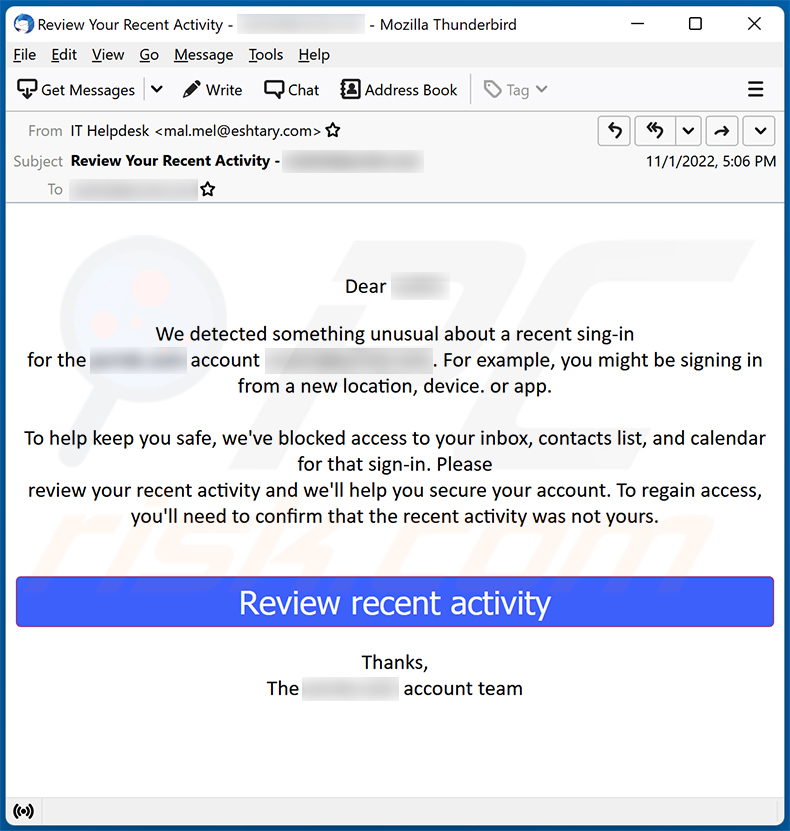
Text presented within:
Subject: Review Your Recent Activity - ********
Dear ********
We detected something unusual about a recent sing-in
for the ******** account ********. For example, you might be signing in from a new location, device. or app.To help keep you safe, we've blocked access to your inbox, contacts list, and calendar for that sign-in. Please
review your recent activity and we'll help you secure your account. To regain access, you'll need to confirm that the recent activity was not yours.Review recent activity
Thanks,
The ******** account team
Yet another example of "Unusual Sign-in Activity" email scam:
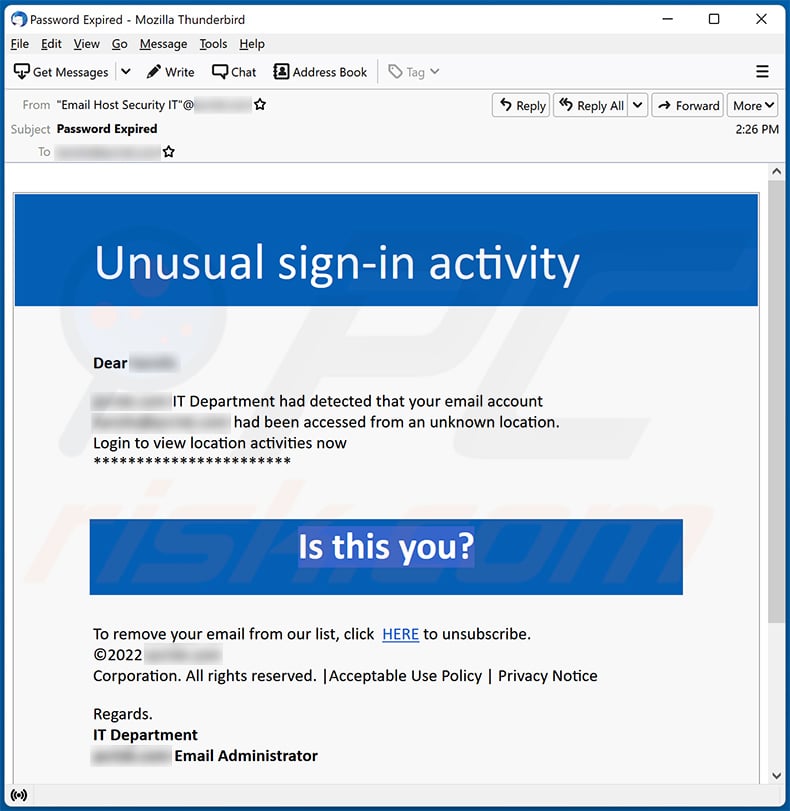
Text presented within:
Subject: Password Expired
Unusual sign-in activity
Dear -
- IT Department had detected that your email account - had been accessed from an unknown location.
Login to view location activities now
***********************
Is this you?To remove your email from our list, click HERE to unsubscribe.
©2022 -
Corporation. All rights reserved. |Acceptable Use Policy | Privacy NoticeRegards.
IT Department
- Email AdministratorThis message is auto-generated from - security server and replies sent to this email can not be delivered.
This email is meant for: -
Screenshot of the promoted phishing site imitating user's email provider:
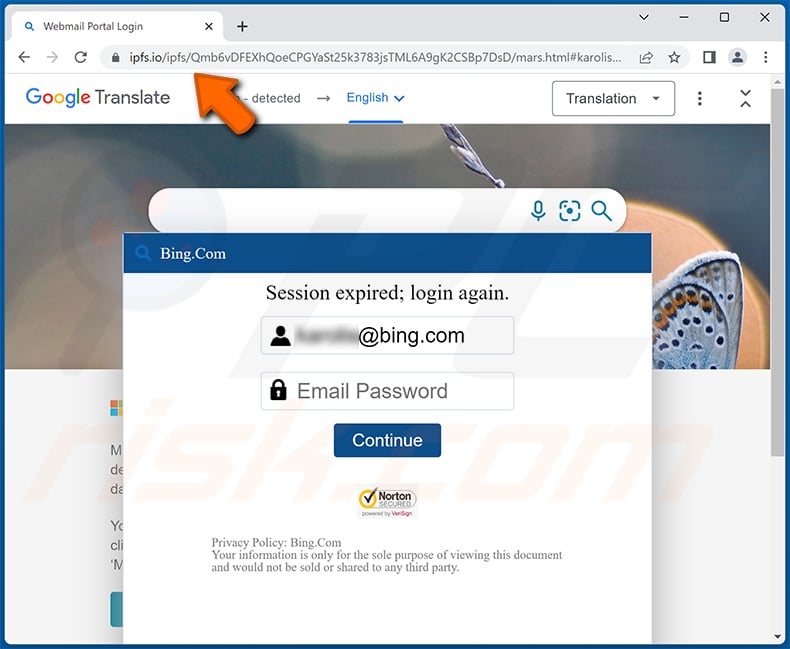
Yet another example of an unusual login activity-themed spam email promoting a phishing site designed to imitate user's email provider:
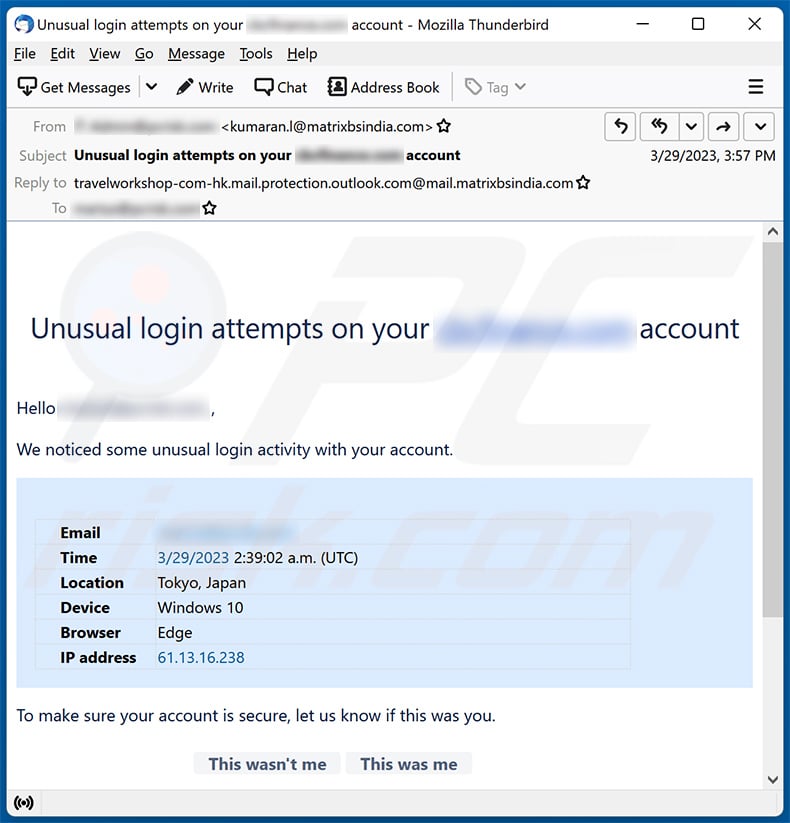
Text presented within:
Subject: Unusual login attempts on your ******** account
Unusual login attempts on your ******** account
Hello ******** ,
We noticed some unusual login activity with your account.
Email ********
Time 3/29/2023 2:39:02 a.m. (UTC)
Location Tokyo, Japan
Device Windows 10
Browser Edge
IP address 61.13.16.238To make sure your account is secure, let us know if this was you.
This wasn't me
This was meWhy am I getting this email?
This message was sent to you by cPanel Cloud
3/29/2023 2:39:02 a.m.
Screenshot of the promoted phishing site:
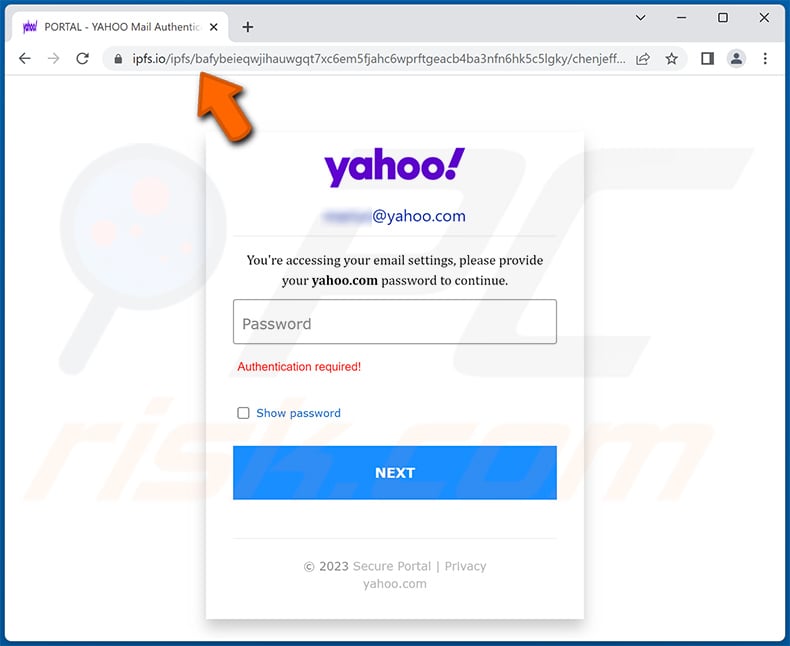
Yet another example of an email from "Unusual Sign-in Activity" spam campaign:
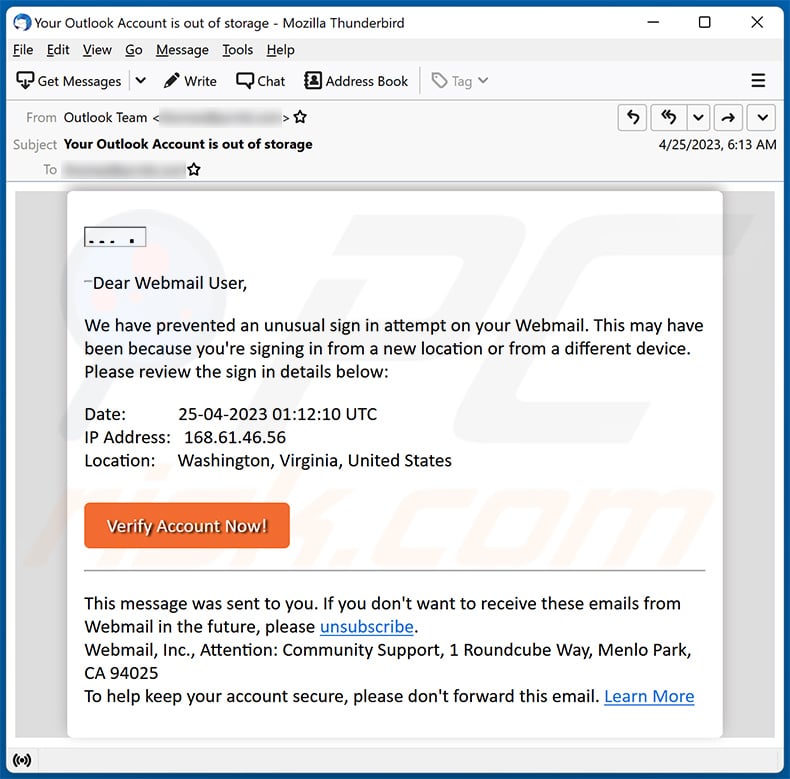
Text presented within:
Subject: Your Outlook Account is out of storage
WebmailDear Webmail User,
We have prevented an unusual sign in attempt on your Webmail. This may have been because you're signing in from a new location or from a different device. Please review the sign in details below:
Date: 25-04-2023 01:12:10 UTC
IP Address: 168.61.46.56
Location: Washington, Virginia, United StatesVerify Account Now!
This message was sent to you. If you don't want to receive these emails from Webmail in the future, please unsubscribe.
Webmail, Inc., Attention: Community Support, 1 Roundcube Way, Menlo Park, CA 94025
To help keep your account secure, please don't forward this email. Learn More
Another example of an email from "Unusual Sign-in Activity" spam campaign:
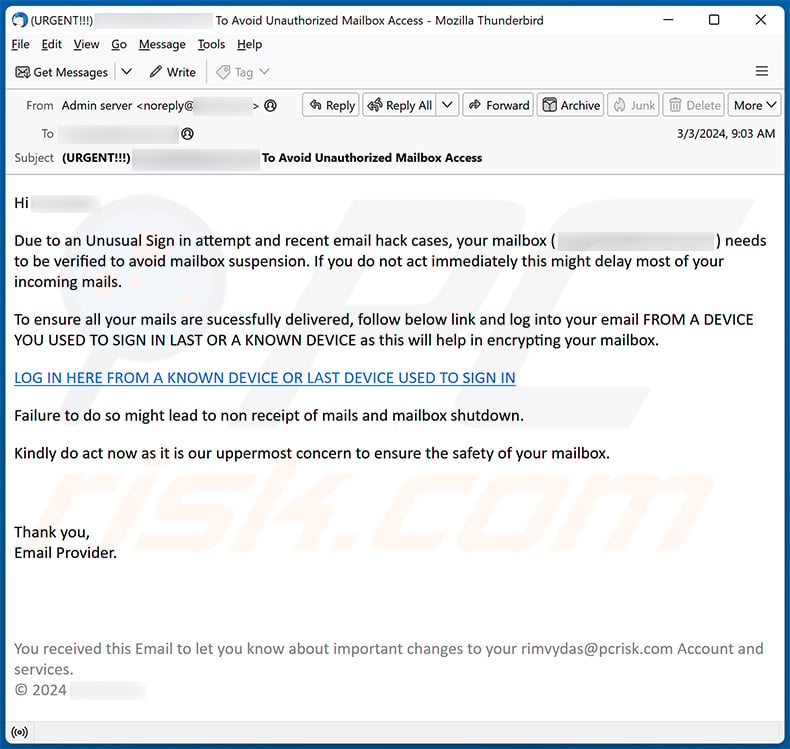
Text presented within:
Subject: (URGENT!!!) ******** To Avoid Unauthorized Mailbox Access
Hi ********,
Due to an Unusual Sign in attempt and recent email hack cases, your mailbox ( ******** ) needs to be verified to avoid mailbox suspension. If you do not act immediately this might delay most of your incoming mails.
To ensure all your mails are sucessfully delivered, follow below link and log into your email FROM A DEVICE YOU USED TO SIGN IN LAST OR A KNOWN DEVICE as this will help in encrypting your mailbox.
LOG IN HERE FROM A KNOWN DEVICE OR LAST DEVICE USED TO SIGN IN
Failure to do so might lead to non receipt of mails and mailbox shutdown.
Kindly do act now as it is our uppermost concern to ensure the safety of your mailbox.
Thank you,
Email Provider.You received this Email to let you know about important changes to your ******** Account and services.
© 2024 ********
Instant automatic malware removal:
Manual threat removal might be a lengthy and complicated process that requires advanced IT skills. Combo Cleaner is a professional automatic malware removal tool that is recommended to get rid of malware. Download it by clicking the button below:
DOWNLOAD Combo CleanerBy downloading any software listed on this website you agree to our Privacy Policy and Terms of Use. To use full-featured product, you have to purchase a license for Combo Cleaner. 7 days free trial available. Combo Cleaner is owned and operated by RCS LT, the parent company of PCRisk.com.
Quick menu:
- What is Unusual Sign-in Activity phishing email?
- Types of malicious emails.
- How to spot a malicious email?
- What to do if you fell for an email scam?
Types of malicious emails:
![]() Phishing Emails
Phishing Emails
Most commonly, cybercriminals use deceptive emails to trick Internet users into giving away their sensitive private information, for example, login information for various online services, email accounts, or online banking information.
Such attacks are called phishing. In a phishing attack, cybercriminals usually send an email message with some popular service logo (for example, Microsoft, DHL, Amazon, Netflix), create urgency (wrong shipping address, expired password, etc.), and place a link which they hope their potential victims will click on.
After clicking the link presented in such email message, victims are redirected to a fake website that looks identical or extremely similar to the original one. Victims are then asked to enter their password, credit card details, or some other information that gets stolen by cybercriminals.
![]() Emails with Malicious Attachments
Emails with Malicious Attachments
Another popular attack vector is email spam with malicious attachments that infect users' computers with malware. Malicious attachments usually carry trojans that are capable of stealing passwords, banking information, and other sensitive information.
In such attacks, cybercriminals' main goal is to trick their potential victims into opening an infected email attachment. To achieve this goal, email messages usually talk about recently received invoices, faxes, or voice messages.
If a potential victim falls for the lure and opens the attachment, their computers get infected, and cybercriminals can collect a lot of sensitive information.
While it's a more complicated method to steal personal information (spam filters and antivirus programs usually detect such attempts), if successful, cybercriminals can get a much wider array of data and can collect information for a long period of time.
![]() Sextortion Emails
Sextortion Emails
This is a type of phishing. In this case, users receive an email claiming that a cybercriminal could access the webcam of the potential victim and has a video recording of one's masturbation.
To get rid of the video, victims are asked to pay a ransom (usually using Bitcoin or another cryptocurrency). Nevertheless, all of these claims are false - users who receive such emails should ignore and delete them.
How to spot a malicious email?
While cyber criminals try to make their lure emails look trustworthy, here are some things that you should look for when trying to spot a phishing email:
- Check the sender's ("from") email address: Hover your mouse over the "from" address and check if it's legitimate. For example, if you received an email from Microsoft, be sure to check if the email address is @microsoft.com and not something suspicious like @m1crosoft.com, @microsfot.com, @account-security-noreply.com, etc.
- Check for generic greetings: If the greeting in the email is "Dear user", "Dear @youremail.com", "Dear valued customer", this should raise suspiciousness. Most commonly, companies call you by your name. Lack of this information could signal a phishing attempt.
- Check the links in the email: Hover your mouse over the link presented in the email, if the link that appears seems suspicious, don't click it. For example, if you received an email from Microsoft and the link in the email shows that it will go to firebasestorage.googleapis.com/v0... you shouldn't trust it. It's best not to click any links in the emails but to visit the company website that sent you the email in the first place.
- Don't blindly trust email attachments: Most commonly, legitimate companies will ask you to log in to their website and to view any documents there; if you received an email with an attachment, it's a good idea to scan it with an antivirus application. Infected email attachments are a common attack vector used by cybercriminals.
To minimise the risk of opening phishing and malicious emails we recommend using Combo Cleaner Antivirus for Windows.
Example of a spam email:

What to do if you fell for an email scam?
- If you clicked on a link in a phishing email and entered your password - be sure to change your password as soon as possible. Usually, cybercriminals collect stolen credentials and then sell them to other groups that use them for malicious purposes. If you change your password in a timely manner, there's a chance that criminals won't have enough time to do any damage.
- If you entered your credit card information - contact your bank as soon as possible and explain the situation. There's a good chance that you will need to cancel your compromised credit card and get a new one.
- If you see any signs of identity theft - you should immediately contact the Federal Trade Commission. This institution will collect information about your situation and create a personal recovery plan.
- If you opened a malicious attachment - your computer is probably infected, you should scan it with a reputable antivirus application. For this purpose, we recommend using Combo Cleaner Antivirus for Windows.
- Help other Internet users - report phishing emails to Anti-Phishing Working Group, FBI’s Internet Crime Complaint Center, National Fraud Information Center and U.S. Department of Justice.
Frequently Asked Questions (FAQ)
Why did I receive this email?
Typically, scammers obtain email addresses after data breaches (after those addresses get leaked). Then they use those addresses in their spam campaigns. Scammers send the same email to all addresses - their emails are not personal.
I have provided my personal information when tricked by this email, what should I do?
If you have provided your password on the fake Webmail (or other) page, change your passwords as soon as possible. In other cases (if you have provided your ID card information, credit card details, social security number, etc.), contact the corresponding authorities.
I have downloaded and opened a file attached to this email, is my computer infected?
It depends on the type of the file. If you have opened an executable file, your computer is most likely infected. Malicious MS Office, PDF documents, and certain other files do not infect computers unless additional steps are taken.
I have read the email but did not open the attachment, is my computer infected?
If you left the malicious file attached to an email unopened, then your computer is not infected. It is harmless to open emails.
Will Combo Cleaner remove malware infections that were present in email attachment?
Yes, Combo Cleaner can detect and remove almost all known malware. Run a full system scan if your computer is infected with high-end malware. Usually, malware of this kind hides deep in the operating system.
Share:

Tomas Meskauskas
Expert security researcher, professional malware analyst
I am passionate about computer security and technology. I have an experience of over 10 years working in various companies related to computer technical issue solving and Internet security. I have been working as an author and editor for pcrisk.com since 2010. Follow me on Twitter and LinkedIn to stay informed about the latest online security threats.
PCrisk security portal is brought by a company RCS LT.
Joined forces of security researchers help educate computer users about the latest online security threats. More information about the company RCS LT.
Our malware removal guides are free. However, if you want to support us you can send us a donation.
DonatePCrisk security portal is brought by a company RCS LT.
Joined forces of security researchers help educate computer users about the latest online security threats. More information about the company RCS LT.
Our malware removal guides are free. However, if you want to support us you can send us a donation.
Donate
▼ Show Discussion